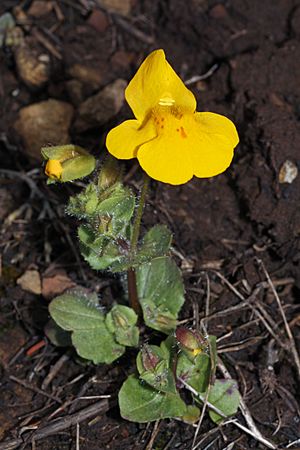Erythranthe guttata facts for kids
Quick facts for kids Erythranthe guttata |
|
|---|---|
 |
|
| Scientific classification | |
| Genus: |
Erythranthe
|
| Species: |
guttata
|
| Synonyms | |
|
|
Erythranthe guttata, also known as the seep monkeyflower or common yellow monkeyflower, is a bright yellow plant. Bees help pollinate its flowers. It can grow for just one year (annual) or come back every year (perennial). This plant used to be called Mimulus guttatus.
Erythranthe guttata is very important for scientists. They study it a lot to learn about plants and genetics. Because of this, it's called a model organism. Scientists have written many papers about it. Its entire genetic code is also being studied in detail.
Contents
About the Monkeyflower
This plant can look quite different depending on where it grows. Scientists sometimes even think some forms might be separate species!
Erythranthe guttata usually grows from 10 to 80 centimeters tall. Its flowers are quite large, about 20 to 40 millimeters long, and shaped like tubes. If it's a perennial plant, it spreads using special stems called stolons or rhizomes. The main stem can grow straight up or lie down. If it lies down, roots might grow from its leaf spots. It can be hairless or have some hairs.
The leaves grow in pairs opposite each other. They are round to oval and usually have rough, uneven edges. The bright yellow flowers grow on a stem called a raceme. Each raceme often has five or more flowers.
The green part that protects the flower bud, called the calyx, has five small parts. These parts are much shorter than the flower itself. Each flower has two sides that are mirror images of each other. It also has two "lips." The top lip usually has two small parts, and the bottom lip has three. The bottom lip often has one large or many small red to reddish-brown spots. The opening of the flower is usually hairy.
Bees, like bumblebees, help pollinate Erythranthe guttata. When plants self-pollinate (meaning they pollinate themselves), it can make their flowers smaller and fewer. It also reduces the quality of their pollen. E. guttata can self-pollinate a lot. Another plant, Erythranthe nasuta, developed from E. guttata a long time ago. E. nasuta mostly self-pollinates now. It also prefers drier places than E. guttata.
Where It Grows
This wild yellow flower grows along streams and wet areas. You can find it across much of western North America. It grows from sea level up to about 3,650 meters high. Both annual and perennial forms are found throughout its range. It blooms in spring in lower areas and in summer in higher, colder places.
You can find Erythranthe guttata in many different environments. This includes the wet areas near the Pacific Ocean, the chaparral in California, and deserts in the Western U.S. It also grows near the geysers in Yellowstone National Park, in mountain meadows, and even on rocky, poor soils. It is also very common in New Zealand near water. Sometimes, it even grows in water, with its leaves floating.
Growing This Plant
Erythranthe guttata is grown by special plant nurseries. It is sold as an ornamental plant for different types of gardens. People use it in traditional gardens, natural landscapes, and habitat gardens. It is also a popular native plant for gardens in California.
How People Use It
The leaves of this plant are safe to eat. You can eat them raw or cooked. Sometimes, people add the leaves to salads instead of lettuce. They have a slightly bitter taste.
Images for kids
See also
 In Spanish: Flor mono para niños
In Spanish: Flor mono para niños


